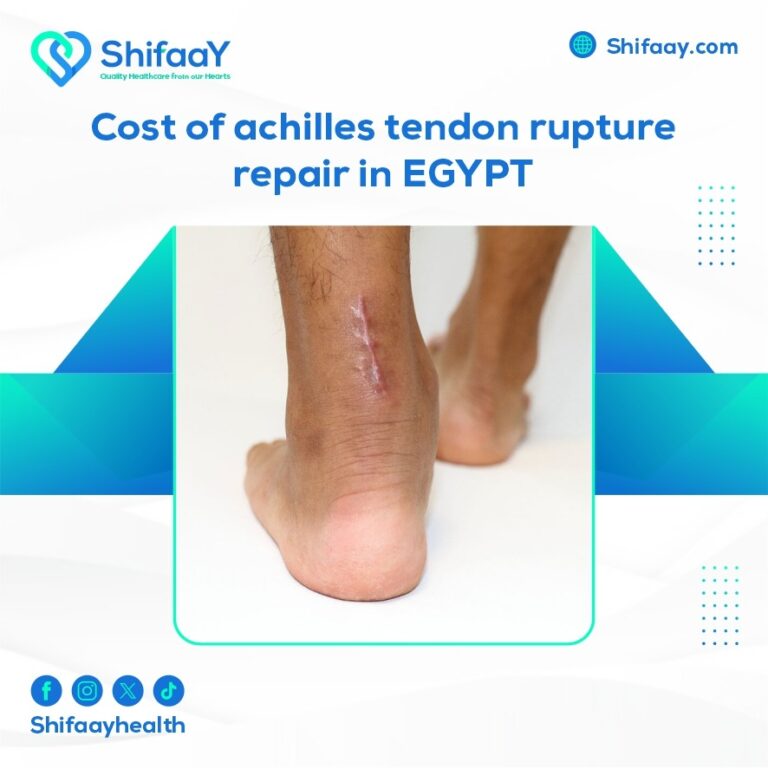Total ankle joint replacement
Total ankle joint replacement surgery is considered one of the most effective vital operations that is typically performed as an alternative solution for all those suffering from severe ankle joint inflammation or degeneration of the ankle joint, which can be the result of a variety of important factors, including joint damage caused by rheumatoid arthritis, severe cartilage damage, and ankle damage caused by age and use. It is important to note that all implants that have been extensively used recently in the process of replacing the ankle joint are now designed to be an exact replica of the human ankle, which could lead to an increasingly better fusion. This is much better for the patient’s prosthesis in the ankle, eliminating the need to attach it with bone cement.
Furthermore, total ankle joint replacements can be regarded as one of the unique surgical procedures that consistently improves the patient’s ability to move their ankle joint and carry out daily tasks in a manner that is either as effective as it was prior to the procedure or as similar with a rate of degeneration that minimizes risk to the surrounding joints and bones. It should be noted that the rheumatoid inflammatory change in the upper ankle joint could be the beginning of the progressive damage to the joint, which could ultimately lead to a restriction in the joint’s range of motion. Because of this, it might be necessary to replace the entire ankle joint, a process known as total ankle joint replacement surgery, which is provided by Shifaay Center, the best medical tourism center in Egypt and is carried out by certain orthopedic specialists. In this article, we will discuss the process of replacing the entire ankle joint and the important details surrounding it.
Ankle arthroscopic surgery

Certainly, a diagnostic ankle arthroscopy can be performed by assessing the ankle and providing a detailed examination. Ankle arthroscopy allows the orthopedist to see the current arrangement of the tissues, cartilage, ligaments, bones, and synovial fluid that may comprise the chain of the ankle joint. When a patient has osteoarthritis of the ankle, an arthroscopy can provide an updated image of the cartilage tissue. This technique can also be used to assess pathological factors, such as loose bones in the synovial fluid of the ankle joint, infection and inflammation, osteophytes of the ankle, damaged bones that are causing pain in the ankle joint, and more.
Furthermore, by using minimally invasive surgical intervention techniques with a diameter of less than one millimeter, the orthopedic physician can see all the pertinent information about the ankle joint. This is because fiber optic techniques can be passed into the ankle joint by making a few tiny incisions, and then fluid is injected to expand the joint, potentially giving the surgeon a large operating field. All obvious problems, such as osteophytes, can be treated during the arthroscopic session. After completing the entire ankle arthroscopy surgery, the specialist doctor closes all the small incisions, and then medical sutures are used.
After arthroscopic ankle surgery, the affected patient can walk on her feet again in twenty-four hours, but she might still experience pain for a full week following the procedure. The surgeon at Shifaay Center recommends using crutches during this time.
Follow also: Rotator cuff surgery in Egypt
Arthroscopic total ankle joint replacement surgery
The significant progress and development seen in the field of arthroscopy in arthroscopic surgeries today has effectively contributed to a tremendous improvement in therapeutic methods. We can also say that arthroscopic surgery has many benefits, such as reducing wound size, relieving pain, and speeding up recovery. The medical conditions that necessitate arthroscopic surgery of the entire ankle joint, as well as the method of arthroscopic surgery, are as follows:
In order to check for abnormalities in the foot bone and its joints, the specialist doctor at Shifaay Center may first make a few small 8 millimeter incisions in the ankle. Depending on the patient’s condition, he may then use a 4.0 or 2.7 millimeter lens in addition to some surgical instruments and medical equipment that may pass through the small incisions that have been opened in order to repair everything that is damaged and abnormal in the foot. This is done via an image in the form of a video recorded on the specialist doctor’s screen.
Therefore, arthroscopic total ankle joint replacement surgery has many advantages. The most significant is that, in contrast to open surgeries, it may help reduce the length of treatment by enabling the patient to recuperate and resume daily activities sooner because the bones and tissues are always less susceptible to damage during the procedure. Furthermore, diabetic patients may experience lighter and simpler pain during this surgery, making them less vulnerable to infections and inflammations that may arise after the procedure. As a result, they may be able to stay in the center for a shorter amount of time.
Ankle joint stabilization operations
Sometimes, many doctors may resort to performing a complete stabilization of the ankle joint if all treatment methods fail to reduce ankle pain resulting from severe arthritis. In this instance, the kind of surgery may vary based on the patient’s age, degree of activity, and joint damage. In most cases, damaged ankle joints may require bone fusion or replacement with an artificial joint. Ankle sprains and instability can be caused by a lateral ankle ligament injury and its exposure to stress or stretching. This can result in a sprain or tear of the ligaments, which can cause the ankle joint to become unstable and uncomfortable. Therefore, in order to tighten and support the ligaments and lower the risk of recurrent or chronic sprains, a total ankle joint replacement and stabilization may be highly important.
Remember that the first step toward stabilizing the ankle joint might be to apply some effective therapeutic techniques to restore ankle stability. The particular therapeutic approach that is used will differ from one case to another depending on the results of different tests and examinations, the level of activity of the patient, and the degree of joint damage. The following are some of the most commonly used non-surgical methods for stabilizing the ankle joint:
- Simple rehabilitation and treatment methods:
Simple rehabilitation and treatment methods depend on the patient’s health condition and the patient’s diagnosis. The condition can be simple and not require surgery, or it can be severe and necessitate surgery. - Physical therapy:
Physical therapy method consists of a variety of exercises and treatments designed to strengthen the ankle joint while also improving balance and movement. In this method, you may be given a variety of exercises to help you carry out activities or sports. - Ankle support:
Ankle support method involves wearing a brace to support the ankle, which prevents it from moving and rotating, as well as contributing to its stability and preventing sprains. - Medicines and drugs:
This method involves the use of medications and anti-inflammatory drugs to reduce inflammation and pain.
The surgical methods for stabilizing the ankle joint are as follows:
- Anatomical repair of the external ankle ligaments:
It is one of the most common methods for stabilizing the ankle joint. This process involves cutting the ligaments that extend on the outside of the ankle joint and repairing them with tension. - Tendon reconstruction of the lateral ankle ligaments:
It is one of the most complex and difficult treatment methods, which may involve strengthening the ligaments by weaving a tendon through the bone in the outer part of the ankle joint, with the goal of providing additional support to the area.
Ankle joint stabilization surgery
The ankle joint is known to be one of the most important joints in the body, bearing a significant portion of the body’s load and allowing the individual to carry out all of his daily activities and movements. It is also possible for someone to sustain severe injuries to the ankle joint; as a result, he needs to assess the ankle’s condition, which could exacerbate his ankle joint pain. In this case, total ankle joint replacement surgery may be the best solution and option for anyone who has been unable to relieve ankle pain caused by osteoarthritis with the most conservative and effective treatment methods. The doctor at Shifaay Center, the best medical tourism center in Egypt chooses the most effective treatment methods based on the age of the disease, its level of activity, and the severity of joint damage or deformity.
There are several effective treatment methods for treating and stabilizing the ankle joint, including:
- Drug treatment:
It is possible to treat the ankle joint with certain drugs and medical combinations that always work to reduce inflammation and pain. - Physical therapy:
Physical therapeutic methods have multiple practical benefits, as they always work to improve the affected condition and provide energy and muscle strength, potentially reducing the load on the body. - Use of stents:
Stents may help to prevent movement in the ankle joint, allowing the patient’s health to improve. - Surgical treatment:
Surgery is a vital and effective therapeutic approach that reliably stabilizes the ankle joint and prevents the disease from progressing.
Ankle joint arthrodesis surgery
Ankle joint arthrodesis surgery is one of the most effective surgical procedures for connecting two bones with a joint so that their fusion does not pose a significant threat to the function of either. This operation is performed as the last, most effective and efficient solution to get rid of all pain in cases of chronic arthritis when other therapeutic methods fail. Furthermore, it is considered a permissible alternative for non-healing fractures and old fractures for the required period, such as ankle joint fractures, middle foot joint fractures, and others.
During the ankle joint arthrodesis procedure, the ankle bones fuse together, forming one bone during the healing process. This may prevent joint movement and alleviate pain caused by joint inflammation. Torql ankle joint replacement surgery is an alternative to this surgical procedure, and the orthopedic surgeon at Shifaay center is highly skilled and experienced in both types of operations. It is worth noting that after the operation and the healing process, which may take several consecutive weeks and up to a year, the surrounding bones may fuse and no movement occurs between them, potentially strengthening the bones.
Ankle joint stabilization procedure
Undoubtedly, the stabilization of the ankle joint always results in the total damage of a joint because, during the procedure, the front leg bone is fixed with the lower bones of the ankle joint. This causes a lack of movement in the ankle joint, making it impossible to bend the foot up, down, or to the sides at the ankle joint, since the ankle joint is what permits the ankle to be bent during ascent and descent. In these situations, it is better to go up and down with your healthy leg first, and then your injured leg.
The wound and bone usually heal within one and a half to three months of the total ankle joint replacement surgery, but this time frame can vary depending on the medical technique used. After healing, the patient might be able to adjust to the environment and carry out his regular activities and movements, such as walking and climbing stairs. However, some people might find it difficult to run, while others might be able to run lightly.
Walking after ankle joint replacement surgery

We all know that walking on the foot after ankle joint replacement surgery is not going to happen quickly or easily; in order to ensure full recovery and joint healing, the patient may need to receive very strict medical attention along with a comprehensive set of guidelines and instructions.
It is worth noting that in order for the medical condition to return to normal life without any pain in the ankle joint that could cause recurring and significantly worsening discomfort during movement or walking, the patient may need to undergo an ankle joint replacement surgery for another treatment period after the operation, the duration of which may vary from case to case.
Follow also: Radiofrequency ablation cost in Egypt
When can I walk after total ankle replacement surgery?
You can start walking on your foot four months after the total ankle joint replacement surgery. The splints are completely removed after 9 to 10 weeks of surgery. After an assessment of the ankle’s condition, a few physical therapy sessions help the ankle heal more quickly and effectively.
How long does a total ankle replacement surgery take?
Some recent advanced studies have shown and confirmed that 90% of total ankle joint replacement surgeries may remain intact about five years after the operation, with this rate dropping to around 80% after eight years.






